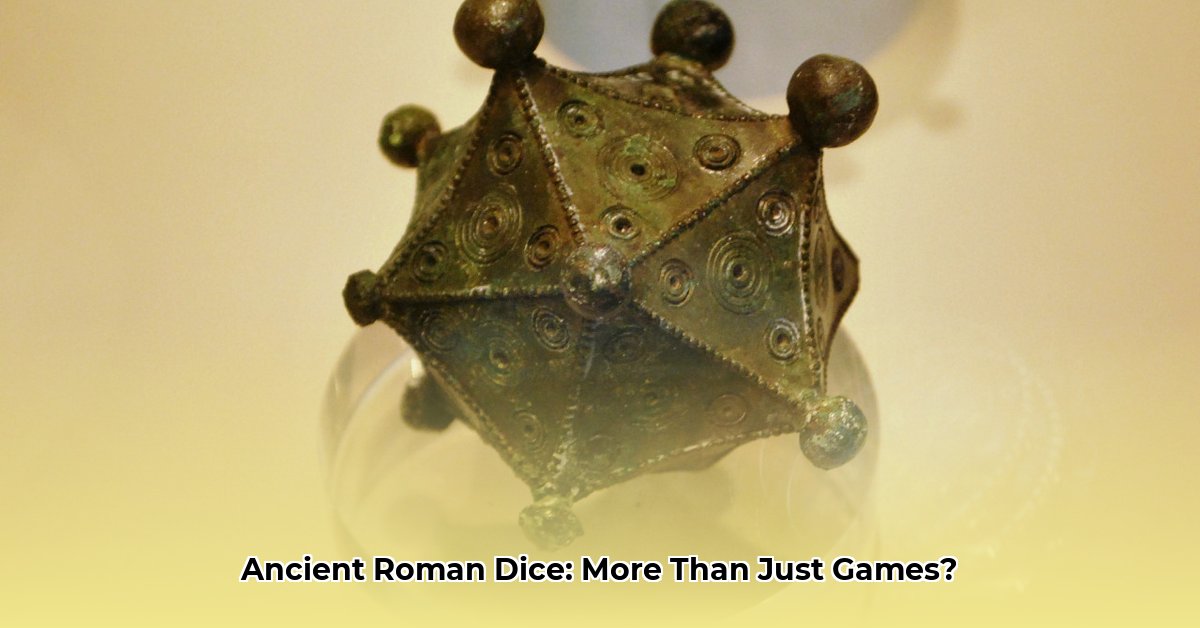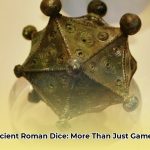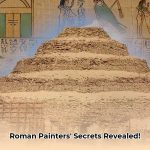Have you ever held an object so ancient that it seemed to whisper secrets from a long-lost world? Such is the case with the fascinating 20-sided dice, or icosahedrons, unearthed from the heart of ancient Rome and Greece. Our modern minds might immediately conjure images of lively taverns and spirited games of chance. But what if these intricately crafted artifacts, made from bone, ivory, or even shimmering rock crystal, held a purpose far grander than mere entertainment? In this exploration, we delve into the archaeological finds, challenge popular assumptions, and illuminate the multifaceted roles these dice may have played in a world deeply intertwined with fate and divine intervention. Were they simply tools for amusement, or did they serve as conduits to the unknown, allowing ancient peoples to glimpse their future? For context on comparable pastimes see these Ancient Roman games.
Rolling the Bones: Ancient Societies, Chance, and the Icosahedron
Imagine for a moment the vibrant, bustling streets of ancient Pompeii or the intellectual hubs of classical Athens. Here, life was a complex interplay of politics, philosophy, and everyday leisure. Gambling and games of chance were certainly prevalent, offering a thrilling escape from daily routines, much like modern pastimes. In this rich tapestry of ancient life, the polyhedral dice, particularly the twenty-sided icosahedron, emerge as profoundly intriguing artifacts. Unlike the familiar six-sided cubes, these wonders boast twenty faces. The term “icosahedron” itself originates from two ancient Greek words: eikosi (meaning “twenty”) and hedra (meaning “face”), precisely describing its form. Each face was meticulously inscribed with Greek letters or Roman numerals, a sophisticated design that points not just to recreational use, but perhaps to something more structured or even symbolic.
Considering the blend of chance and skill inherent in games of the era, it’s interesting to note how team building activities today similarly foster collaboration and strategic thinking.
The ingenuity displayed in these gaming pieces is just one example of the sophistication found throughout the era, evident in everything from their pastimes to their architecture, and you can discover more when you unlock ancient Roman architecture secrets.
The earliest known dice predate even the Greeks and Romans, with excavations at the Neolithic village of Skara Brae in Orkney revealing bone dice from between 3100 and 2400 BC. These early examples, marked with notches and grooves, highlight humanity’s long-standing fascination with chance. By the classical era, the precision of icosahedron dice manufacture and their consistent marking systems suggest a logical framework for their application. The thrill of leaving one’s fate to a random roll of a twenty-sided die surely provided both excitement and, for some, perhaps even a fleeting sense of control over an often-unpredictable existence. While direct rulebooks for specific icosahedron games are scarce, their prevalence indicates a significant role within ancient leisure.
Crafting Fate: The Materials and Their Meanings
The materials from which these ancient dice were fashioned tell their own compelling story, hinting at the social strata and perceived importance of their owners. While many were carved from common bone or ivory, archaeological discoveries reveal opulent examples crafted from precious materials such as rock crystal, alabaster, onyx, marble, jet, and amber. The labor and artistry required to shape such difficult materials into perfect icosahedrons denote significant value and prestige.
A humble bone die might have been a common gaming tool, accessible to many, but a rock crystal icosahedron likely belonged to the social elite, perhaps even royalty. An exquisite Roman rock crystal icosahedron, for instance, housed in the Musée du Louvre, stands as a testament to this luxurious craftsmanship. Measuring just one centimeter high, each of its twenty triangular faces bears both a Latin letter and a corresponding Roman numeral. The ten lateral faces are inscribed with letters A through K and numerals 1 to 10. The upper five triangles display letters L to P and numbers 11 to 15, while the lower five triangles bear Q through V and numbers 16 to 20. This precise and intricate labeling system on such valuable materials suggests a purpose extending far beyond simple recreation, blurring the lines between game piece and sacred object.
Beyond the Game Board: The Icosahedron’s Profound Role in Divination
This brings us to a compelling realization: while gaming is a plausible function, many scholars now contend that ancient icosahedron dice held a far more profound, spiritual purpose: divination. For cultures steeped in belief in omens, fate, and the direct intervention of deities, tools that could seemingly channel divine messages were invaluable. This theory posits that these dice were used in conjunction with oracle books, such as the famous Homeromanteion.
Composed in the 2nd or 3rd century AD, the Homeromanteion is a Greek oracle book, preserved in three papyri, that explicitly refers to the practice of throwing lots to obtain a number. This number would then be used, through certain algorithms, to look up ready-prepared oracle questions and responses within the text. Imagine the scene: an individual, seeking guidance on a crucial decision, would consult a sacred text. A toss of the icosahedron would then yield a specific number or letter, which correlated to a particular passage or answer within the oracle, acting like a cosmic random selector for a fortune. This method of seeking divine insight through chance operations, known as cleromancy, was a widespread practice throughout the ancient world. The Greek traveler Pausanias, for instance, documented the use of astragaloi (knucklebones) with numbered lists to communicate with the gods, illustrating a similar principle. This fusion of chance and prophecy highlights how deeply integrated spirituality was within the daily lives of ancient Romans and Greeks, influencing decisions at every social level.
Further supporting the divinatory theory is a unique icosahedron discovered in the Dakhleh Oasis in Egypt in the 1980s. Each of its faces is inscribed with the name of a different Egyptian god in Demotic, the Egyptian script of the late periods. Divination – seeking advice about the unknown from the supernatural – seems the most likely purpose for this Dakhleh die: the polyhedron might have been thrown to determine which deity might assist the practitioner. Even dice inscribed with simpler letters or numbers could relate to divination, providing the random input for complex oracle systems.
The Enduring Mystery of the Roman Dodecahedron
It is important to note that while the purpose of the icosahedron has strong theoretical links to gaming and divination, another ancient polyhedral die, the Roman dodecahedron (a 12-sided object), remains largely shrouded in mystery. Primarily found in northern Gaul and Roman Germany, over a hundred Roman dodecahedrons have been discovered since the first recorded find in 1739. Unlike the icosahedron, there is no textual evidence or clear contextual clues regarding their function. Theories abound, ranging from candlestick holders (due to wax residue found in one instance) to dice, survey instruments, devices for determining optimal sowing dates for winter grain, or even gauges for calibrating water pipes. Some hypotheses suggest they were used for knitting gloves, with the various holes accommodating different finger sizes, or even as battlefield range-finding devices for projectiles. However, none of these theories have conclusive proof. The stark contrast between the relatively well-supported divinatory use of the icosahedron and the persistent enigma of the dodecahedron underscores the challenges and ongoing fascination of archaeological research into ancient artifacts.
Unearthing Understanding: Archaeological Findings and Modern Research
The geographical distribution of ancient icosahedron dice provides invaluable clues about their cultural impact and perceived importance. Discoveries across a wide array of ancient sites, from the heart of Rome to the provinces of Egypt, demonstrate their widespread adoption. Analyzing the specific contexts in which these dice are found—whether in domestic settings, religious sanctuaries, or burial sites—allows archaeologists to infer their primary uses. For example, a die found within an oracle’s temple would lend stronger credence to its divinatory role than one found amidst gaming tokens in a private home. This meticulous contextual analysis is critical for moving beyond mere speculation and building robust theories.
Today, major institutions like the Metropolitan Museum of Art in New York play a pivotal role in preserving these delicate artifacts. Through careful cataloging, conservation, and detailed study, museums and researchers continue to unravel the mysteries embedded within these ancient objects. Ongoing research projects combine archaeological evidence with linguistic analysis of ancient texts and religious studies to paint a more complete picture of Roman and Greek society’s relationship with chance, fate, and the divine. This interdisciplinary approach is crucial; for instance, examining the precise inscriptions on the dice in conjunction with known divination practices can reveal subtle patterns or coded messages previously overlooked. What new insights might future excavations yield with advanced imaging and analytical techniques? The continued study of these enigmatic objects promises to deepen our understanding of ancient beliefs and daily life.
Pathways for Deeper Exploration
The study of ancient Roman icosahedron dice is far from complete, offering fertile ground for continued exploration. Researchers are actively pursuing several avenues to enhance our understanding:
- Comprehensive Digital Cataloging: Developing digital databases of all known icosahedron dice, meticulously documenting their material, dimensions, inscriptions, and precise find locations. This systematic approach allows for advanced comparative analysis, statistical modeling of features, and the identification of regional variations or consistent patterns that might reveal specific cultural uses.
- Advanced Textual Analysis: Employing computational linguistics and digital humanities tools to analyze surviving ancient oracle texts, such as the Homeromanteion, in conjunction with the dice inscriptions. This could uncover previously unrecognized algorithms or interpretations linking the dice rolls to divinatory outcomes, providing a clearer understanding of how these systems functioned.
- Experimental Archaeology: Recreating ancient icosahedron dice using historically accurate materials and methods. Modern practitioners can then conduct experiments to test theories of use, whether for gaming, divination, or other proposed functions. This hands-on approach offers unique insights into the practical challenges and potential applications of these artifacts.
- Public Engagement and Interactivity: Designing museum exhibits and online platforms that allow the public to interact with digital replicas of these dice and explore the concepts of fate, chance, and belief in ancient cultures. Educational initiatives, including potentially historically informed game designs, can foster a deeper appreciation for ancient civilizations and stimulate new interpretations and theories.
Ultimately, the ancient Roman icosahedron dice are far more than simple game pieces. They are tangible links to humanity’s enduring quest for meaning, control, and understanding in a world governed by both chance and profound belief. Their study illuminates the sophisticated interplay of entertainment, spirituality, and intellectual curiosity that defined ancient civilizations, offering a fascinating window into the very fabric of human experience.










